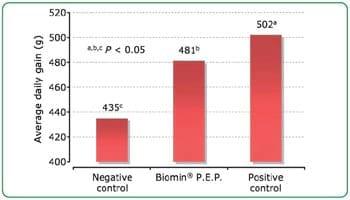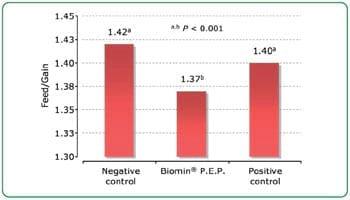Biomin® P.E.P. 125 Scientific trial with piglets
Published: April 5, 2007
By: Kansas State University, USA / Arthur Kroismayr (Courtesy of Biomin)

Aim of the Trial
This trial was carried out to assess the efficacy of phytogenics (Biomin® P.E.P.) in comparison to Antibiotic Growth Promoters (AGPs) in weaned piglets.
Trial Design
192 weanling pigs (PIC) with an average age of 22 day and an average initial body weight (BW) of 5.9 kg were randomly assigned to three dietary treatments, comprising eight replications per treatment with six piglets per replication. Piglets were fed ad libitum one of three experimental diets in two feeding phases (day 0–14 post-weaning and day 14–42 post-weaning):
Treatment 1: Negative control (NC, no additives)
Treatment 2: NC + Biomin® P.E.P. 125 (125 g/t)
Treatment 3: Positive control (PC, 140 g/t neomycin sulfate + 140 g/t oxytetracycline HCl)
The experimental diets were based on corn and soybean meal (Table1). In phase 1, whey and fish meal were included into the diets to secure a high availability of nutrients in the early stage of fattening. For treatment 2, the Negative Control diet was supplemented with Biomin® P.E.P. 125, whereas the Positive Control contained antibiotics.
| Table 1 Diet composition (as-fed basis) |
 |
Results and Discussion
Addition of Biomin® P.E.P. to the diets successfully improved growth performance in piglets post-weaning. As compared to the Negative Control, average daily weight gain was significantly (P = 0.02) increased by 6% through Biomin® P.E.P. (Figure 1).
Furthermore, feed efficiency (feed/gain) was significantly improved by 3.5% (Figure 2). In contrast there was no significant difference (P = 0.26) in feed efficiency between the NC and PC which contained antibiotics.
The increase in average daily gain through medication with AGPs in the PC obviously resulted from a significant (P < 0.001) increase in feed intake (Figure 3). Piglets fed the diet with antibiotics consumed 9.8 or 7.1% more feed as compared to pigs offered the NC diet or the diet supplemented with Biomin® P.E.P. at 125 g/t. However, this increase was not accompanied by a significant improvement in feed conversion. A significant better FCR, as observed in pigs fed Biomin® P.E.P., essentially adds to profitability, especially when there is a trend towards overall increasing feed costs.
 |
| Figure 1: Effect of Biomin® P.E.P. on average daily weight gain of piglets |
 |
| Figure 2: Effect of Biomin® P.E.P. on feed efficiency (feed/gain) in piglets |
 |
| Figure 3: Effect of Biomin® P.E.P. on feed intake of piglets |
Conclusions
Adding Biomin® P.E.P. to nursery diets improved post-weaning growth performance and can be used effectively as growth promoters in diets that do not contain antibiotics. The growth response observed from antibiotics was largely driven by feed intake while the benefit of Biomin® P.E.P. was an improvement in feed efficiency.
Related topics:
Recommend
Comment
Share

Would you like to discuss another topic? Create a new post to engage with experts in the community.





